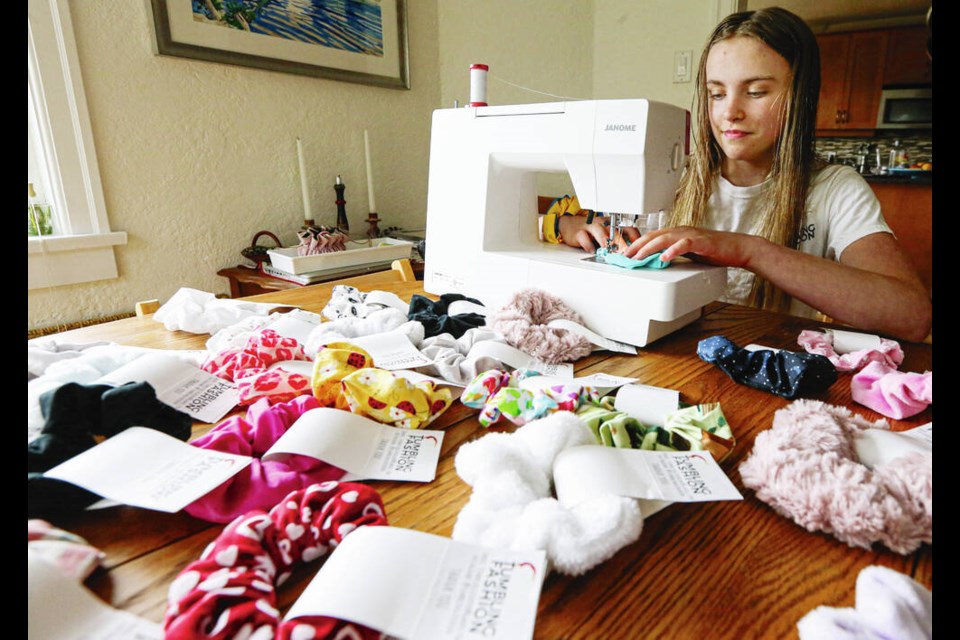Grade 7 student Amira Rudnycka discovered a passion for business during the pandemic, using her sewing machine to turn out countless hair scrunchies, tote bags and wall hangers that she sold via social media.
But she wanted to learn more about marketing, sales and working with customers, so she signed up for the University of Victoria’s free Kidovate program, which was launched in 2019 to introduce young people to the basics of being an entrepreneur.
“It just seemed like a fun opportunity to get experience in marketing and business,” Amira said.
Kidovate, which took a two-year break because of the pandemic, is back again this year, geared to middle and high school students, mainly ages 12 to 17.
Students follow a graphic workbook that provides a step-by-step guide on how to set up a venture. If participants wish, they can arrange to have a student mentor through UVic’s Gustavson School of Business.
The program is flexible and designed to suit a classroom as well as young people working on their own. UVic approached schools this year to find out if they wanted to promote it internally. Some did, and are running Kidovate in classrooms. Lesson plans have been developed for teachers wishing to involve a class in Kidovate.
The program aims to foster an entrepreneurial spirit, develop business acumen and instill a sense of corporate social responsibility.
Nolan Kaercher and friend Sid Napier, both in Grade 6 at Bayside Middle School, are partnering to build products from cedar and fir logs. They use rounds from the logs to create tables, bottle openers, trivets and coasters. They have also wrapped glass milk bottles in hemp, are baking brownies, and will be selling Sid’s brother’s sketches.
They’ve been working with a spreadsheet and spending much of their free time this month creating their products under the name Sinoly Woodworks.
This year’s Kidovate program culminates with a marketplace on April 9 in the centre court of the Bay Centre downtown from 10 a.m. to 3 p.m. Up to 70 students will showcase products and services on tables they decorate themselves.
The first Saturday after spring break was deliberately selected for the market, to give participants time to prepare products and fine-tune sales pitches.
Nolan said he “definitely” learned a lot about business by taking part in Kidovate. Sid said it helped them figure out matters such as pricing and advertising on signs.
Sid and Nolan’s products will sell for between $2 and $25, for a table. If everything sells, they will bring in $933, Sid said.
Kidovate encourages students to contribute to a charity, so the boys are donating 15 per cent of their profits to the Canadian Red Cross to help Ukrainians.
Amira will be selling scrunchies for $4 to $6, tote bags for $10, and macrame wall plant hangers and owl wall hangers for $15 to $20. Products are advertised on her Instagram page, instagram.com/tumblingfashion.
Along with her regular products, Amira plans to sell blue and yellow scrunchies, bracelets and earrings to raise money for the Canadian Red Cross’s humanitarian work with Ukrainians. Each blue and yellow item will sell for $4. Amira and friends have already raised $320 for the Red Cross.
Amira is still figuring out how many of each product to make for the market, but she figures she’ll take 60 scrunchies — her best seller — a dozen macrame plant hangers, about five tote bags, and some drawstring bags.
Georgia Fraser, Amira’s schoolmate at École Intermediaire Lansdowne Middle School, is another Kidovate participant. Her parents had her draw up a basic business plan for Georgia’s Crafts prior to signing up.
Georgia, who is making faux pearl earrings, necklaces and bracelets, clay earrings, and tote bags out of recycled materials for the market, is keen to develop her entrepreneurial skills, saying: “I love business.”
She borrowed money to buy supplies from her parents, and plans to pay them back out of her profits.
Georgia learned a key lesson early on when she needed to buy more materials: “I had to balance out my materials so I can make the most of what I have.”
Kidovate has taught her how to market products and to understand the competition, said Georgia, who has been devoting a lot of time to thinking about the best way to set up her table to attract as many customers as possible.
She plans to donate 10 per cent of profits, including five per cent to the Canadian Red Cross to support its work with Ukrainians, and the balance to Muscular Dystrophy Canada, a charity that’s dear to her heart, since her brother has muscular dystrophy.
UVic entrepreneurship professor Brock Smith said 30 students participated in Kidovate’s first year, selling everything from crocheted items to bath bombs, soaps and watercolour paintings.
“We are one of the few [business] schools in Canada that has a specialization in entrepreneurship, so if people are interested in that, there’s a local solutions where they can go to school to learn more about it,” Smith said.
Teacher Tania Chavez at the Victoria School for Ideal Education said 19 students in grades 6, 7 and 8 from her school signed up this year for Kidovate. “It’s a way to do math without making it like schoolwork for them.”
They are so invested in making something and excited to take part that they happily make their items at home, she said.
A lot of the students choose to work as a group on their projects.
Youngsters are preparing a variety of items for the market, including rings made from forks, candles, bath bombs, stickers and art pieces, she said.
The next Kidovate program will run in 2023. Smith is hoping to one day see 200 to 300 students sign up.
For more information and to connect with the program, go to kidovate.ca.

